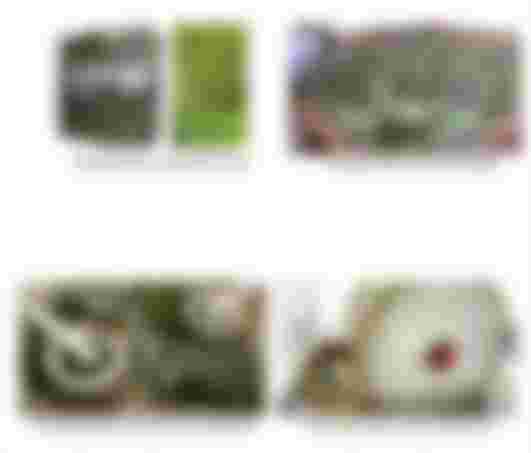INTRODUCTION
Carica papaya, which comes from Caricaceae family, is native to eastern Central America and was cultivated long before the arrival of the Europeans; Spanish and Portuguese invaders took the fruit and quickly spread it to their other settlements. "Papaya" is the most widely cultivated and best known species. It is cultivated nearly all over the tropics and subtropics for its luscious fruits and source of commercial papain, an enzyme, with pronounced proteolytic activity, valuable in the pharmaceuticals, cosmetics and textile industry. Papaya is a fast-growing, short-lived, single-stemmed small tree, 2-10 m tall, with a straight, cylindrical, soft hollow gray trunk roughened by large leaves and scars of inflorescence. Papaya leaves contain phenolic compounds papain and alkaloids that act as strong antioxidants which, in turn, enhance the immunity of the body. It is widely used due to its medicinal properties. Leaves of this plant have been used by various indigenous populations. Several studies have found that papaya extract has improved the number of platelets in dengue patients. Papaya leaves have been successfully used in folk medicine for the prevention of dengue infections by palm oil suspensions of powdered leaves. The leaf may potentially serve as a good therapeutic agent for protection against gastric ulcer and oxidative stress (IJPPR, 2014).
Various experiments have been carried out on the use of the different portions of Papaya tree in the search of human wellbeing and wellness. Various researchers have concentrated on the use of Papaya leaves for organic tea production and food supplements. A number of government departments are specifically using Papaya leaves to fulfill particular objectives. Papaya leaf has a numberless of benefits. In some parts of Asia, the young leaves of the papaya are steamed and eaten like spinach. Fresh, green papaya leaf is an antiseptic, whilst the brown, dried papaya leaf is the best as a tonic and blood purifier (Atta, 1999). Recent reports have claimed possible beneficial effects of papaya leaf juice in treating patients with dengue viral infections (Yunita et al., 2012). The extracts of both the leaves and fruit are known to contain several proteins and alkaloids with important pharmaceutical, medical, and industrial applications. Interestingly, papaya fruit juice and leaf extract have demonstrated anti-cancer (Rahmat et al., 2002). In a recent study it is found that, the powder from papaya leaves has substances responsible for the release and production of thrombocytes/platelets (Sathasivam et al., 2009).
The increasing intake of herbal tea made from raw Papaya leaves (Carica papaya L.) is now recognized for its importance to human health and lifestyle. People who want to follow a healthier lifestyle tend to minimize the consumption of fast food drinks and to prefer healthier drinks such as herbal teas. In addition, the health and wellness food industry is rising due to an increasing number of people with health problems. Consumer preferences for more unprocessed food lead to a huge appetite for organic ingredients, such as herbal tea. In USA, almost 80 percent of the household drinks tea whether it is consumed as hot or iced cold. In 2016, almost 84 billion serving of tea or more than 3.8 billion gallons were consumed (Tea Association of the USA, 2016). Development comes from all sectors led by diversity, simplicity, health benefits, affordability, affordability, increased creativity and the discovery of exclusive, tasty and high-quality specialty teas.
Despite the strong prospects for the market for herbal teas, the conventional method of processing these products is still practiced. In the case of papaya leaves, the dried leaves are ground or turned into powder by means of mortar and pestle, a local grain grinder or by rubbing the dried leaves against a thin screen. Papaya Leaves powder is considered a natural multivitamin supplement. Papaya dried leaves pulverized into fine powder has a fine grain size and can be converted into organic papaya leaves tea. Microwave process, infrared, lyophilization process, oven drying or convection drying, solar drying and shadow drying are various techniques used to dry papaya leaves.
The general term size reduction includes the mechanical cutting, shearing, crushing, grinding and milling of dried papaya leaves. Without making a big difference in the chemical properties of the material, these procedures reveal more surface space for digestion. Around the same time, the removal of scales facilitates uniform mixing. And while uniformity in the size and shape of the reduced particles is generally expected, it is rarely obtained. With a lack of pulverizing technology, farmers are facing weak agricultural productivity and lower income prospects, resulting in a deliberate increase in the demand for manufactured goods. (ECHO,2007).
The manufacturing of organic powdered products offers a simpler way of promoting the powder of papaya leaves and maintaining a balanced lifestyle. Processing them into powder can help to improve the living conditions of laborers, processors and farmers by earning extra income. The extension of production for both domestic and export markets could also be of benefit. In addition, demand for goods purchased by health-conscious customers may be targeted.
Processing Operations and Product Standards of Papaya Leaves
The growing interest and growing use of herbal products as herbal medicines has stimulated the need for control. Significant attention must be paid to the essence and features of herbal drugs in the light of statutory requirements and procedures. (World Health Organisation Western Pacific Regional Office, 1997).
Changes to other areas of the industry, such as organic tea, should also be promoted and the health advantages of tea consumption should be used more widely to support usage in both producing and importing countries. However, knowledge of and compliance with food protection and quality requirements is important in reaching future growth markets.
The herbal tea powder is processed for human consumption. It is produced by grinding the dried leaves into fine particles. The process is shown in Figure 1 consists of four stages: harvesting of leaves, drying, grinding and packaging.

Even before current period, the Philippines did not have standard varieties of papaya leaves.
Industry Situationer
Over the last decades, organic food goods have been the most natural alternative to traditional food consumption. Of the many organic food qualities that consumers identify in organic food, wellbeing has been identified as the primary reason to purchase organic-certified products. The changing customer purchasing habits, increasing customer worries about health, the atmosphere and animal welfare, along with their ability to pay high prices for healthier food, are fuelling demand for organic food and beverage products in the Asia-Pacific region.
Huge corporations see this as an advantage that has a beneficial impact as a result of the growing demand in the local and global industries. Major industry participants competed in terms of growing, selling and spending in the production of papaya powder and its by-products.
Organic Tea Industry
Tea is the second most commonly consumed drink in the world, after water. There are several types of teas, based on their oxidation: green, yellow, oolong and black. Well recognized varieties of black tea include Darjeeling, Assam, Turkish and Ceylon teas.
This fragrant beverage emerged in 2737 BC in China. According to tradition, the Chinese emperor was seated under the tree of Camellia Sinensis, while his servant boiled drinking water. The wind blows some leaves from the tree into the bath, and the emperor wanted to try the drink that his servant had mistakenly made.
This fragrant drink emerged in China in 2737 BC. According to the story, the Chinese emperor stood under the tree of Camellia sinensis while his servant boiled drinking water. The wind blows some leaves from the tree into the bath, and the emperor wanted to try the drink that his servant had made by mistake. The tea community had been developed in China for many centuries before it had come to the West. Tea drinking was introduced in Japan in the late eighth century and became an important part of Japanese society. Tea is regarded as one of the country's cultural drinks in the United Kingdom. Tea is also a popular drink in Middle Eastern cultures.
In 2016, Turkey was the highest tea-consuming country in the world, with per capita tea intake of about 6.96 pounds per year. On the other hand, China had an annual intake of 1.25 pounds per person. In 2015, China was the world's top producer of tea, followed by India and Kenya. Around 5.2 million metric tons of teas were produced worldwide that year.
The production of tea in the Philippines is not yet widespread. However, herbal tea is a popular beverage in the Philippines produced by the spread or boiling of herbs, spices, fruits, etc. It is believed that herbal teas support to improve the mind and body and encourage a person's general well-being. The most popular herbal teas on the market are malunggay, ginger, banaba, guyabano, ampalaya and pito-pito.
People are actually seeking better health and more fresh food, which is why this would be a huge opportunity for the tea industry. In order to help trends in the tea industry, more investigation and analysis is needed to recognize market needs and produce the right product.
Processing Technologies
Several innovations have been patented for fast and comfortable production of pulverized and formed products, such as herbal teas and organic sweeteners. Traditional manufacturing processes are increasingly being replaced by emerging developments.
Popular herbal tea processing processes were the use of mortar and pestle, wheel press, water mill and animal mill (horse mill). Mortar and pestle is a tool used in the West-African countryside. In this method, the crushing mortar is disrupted by many sievings that allow the processing of a range of different products, from meal to the finest flours. Its efficiency is the advantage of this system. In the other side, the process of the wheel mill (original of the Neolithic period) uses a flat stone slab as well as a grinding stone. The hand-operated wheel is used to grind grains deposited on the slab. Two or three loops of the wheel are enough to get a meal of food that eventually comes out of the slab. This is a form that is still used in rural parts in East Africa.
In the case of papaya leaves, the dried leaves are ground or turned into powder by means of mortar and pestle, a local grain grinder or by rubbing the dried leaves against a thin screen. Papaya Leaves powder is considered a natural multivitamin supplement. Papaya dried leaves pulverized into fine powder has a fine grain size and can be converted into organic papaya leaves tea. Microwave process, infrared, lyophilization process, oven drying or convection drying, solar drying and shadow drying are various techniques used to dry papaya leaves.
Existing Technology
The devolved nature of organic tea production in the country has made it difficult to ascertain due to the traditional production processes used. In view of this matter, the traditional methods were adapted into modernized processes in producing valued products.
Throughout the years, several pulverizing machines were invented. Developing countries such as the USA, China, and Japan are the leading manufacturers of improved processing technologies for this particular industry.
In the Philippine, the modernized machinery is not yet competitive due to the lack of processing facilities and the unavailability of processing machines in different areas. Thus, the processors need to upgrade their processing technology and standard operating parameters to be able to cope with the increasing demand in both local and export markets for these particular by-products.
If the herbal and organic sugar industry is rapidly growing due to consumers’ awareness, the local producers should upgrade their processing technologies in order to produce quality nutritious products.

References
Dev et al (2014). Processing and Quality Evaluation of Green Papaya (Carica
papaya L.) Leaf Tea. Retrieved from http://www.jakraya.com/journal/pdf/3-jacsArticle_1.pdf
Nafiu et al (2019). Papaya (Carica papaya L., Pawpaw). Retrieved from
https://www.sciencedirect.com/topics/agricultural-and-biological- sciences/
carica-papaya
Ugo et al (2019). Nutrient Composition of Carica Papaya Leaves Extracts. Retrieved
from http://www.fortunejournals.com/articles/nutrient-composition-of-carica-papaya-leaves-extracts.pdf
Chua, G. (2018). The Philippines Fresh Papaya Export Value Chain. Retrieved from
The Philippines Recommends for Papaya Committee 2005. The Philippines recommends for papaya. Los Baños, Laguna: PCARRD-DOST, 2006. 91p. – (Philippines Recommends Series No. 27-C).
Rizzo et al (2020). Organic Food Consumption: The Relevance of the Health
Attribute. Retrived from https://www.mdpi.com/2071-1050/12/2/595/pdf
Juárez-Rojop IE, et al. Hypoglycemic effect of Carica papaya leaves in streptozotocin-
induced diabetic rats.BMC Complement Altern Med. 2012 Nov 28;12:236
Sudhakar N, Vidhya (2014) TRM Potential medicinal properties of carica papaya
linn.- A mini review. International Journal of Pharmacy and Pharmaceutical Sciences 6(2): 1-4
Yogiraj V, et. al (2014). Carica papaya Linn: An Overview. International Journal
Herbal Medicine 2(5): 1-8
Isa, M. (2010). Extraction Of Papain Enzymes From Papaya Leaves. Retrieved from
http://umpir.ump.edu.my/id/eprint/3422/1/CD5947_MASITA_MAT_ISA_X.pdf
Campostrini, E. (2018). Environmental Factors Controlling Carbon Assimilation,
Growth, and Yield of Papaya (Carica papaya L.) Under Water-Scarcity Scenarios. Retrieved from https://www.sciencedirect.com/ science/article/pii/
B9780128131640000193


kadami mo baga sources ghorl. sabi mo kulang kulang. hahahha